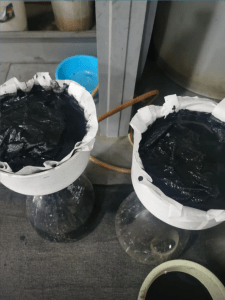Call us now:
physical test
Test Acid - Rub a piece on your touchstone and create a residual "streak" several inches long. Apply three different acid spots; the karat of the nugget you suspect is scrap, then acid to test the karat above and below the nugget. If you suspect the piece is 14kt, the 10kt acid shouldn't dissolve it, the 14kt acid should dissolve it, but the 18kt acid will definitely dissolve it. If you test 14kt but the 10kt acid dissolves the streaks, you know the part is below 10kt. Acid is a good way to give you an idea of what a piece is gold and its carat range. Here are some considerations for using acids.
Do not scratch from common solder joints. Many times the repair point doesn't match the carat of the original and will give you wrong results, usually on the lower end, but I know some jewelers who only use 18kt solder to save on buying more than one type of solder, which can lead to higher than accurate results.
Make sure the acid is good. About once a month, do an acid test on the test needle set that came with your test kit, or if you don't have a needle set, take some parts that you have verified carats and use these to verify that your acid retains them effectiveness.
Remember acid can only tell you if a piece is above or below a certain threshold. You can have a stamped 14kt tablet that doesn't dissolve at 14kt acid but dissolves at 10kt. You just know the piece is between 10kt and 14kt.
Magnetic Test - All carat quality scrap gold is non-magnetic. This is called a negative result test...it confirms that something is not what you were told, but not that it is. If a piece isn't attracted to a strong earth magnet...it may or may not be gold, but if it does attract a good magnet, you know it's not gold.
physical inspection
Hallmark Stamp – Find an iconic stamp. This stamp is used to indicate what a piece is made of. Stamps usually appear on the clasp of a necklace or bracelet, or on the inner ring of a ring. American-made products are labeled Karat, while European-made products are usually labeled for purity. You might see 10k, which means the piece is of American origin, or at least intended for the American market, or you might see 0.415, which means it's 41.5% pure and intended for the European market. Although they are all the same purity. One thing to keep in mind is that the Logos Act came into effect in 1973, so it is possible to find some works without the logo if they were produced before 1973.
Spotting or Discoloration - The appearance of a piece can tell you a lot. If you see blackened or greenish spots, it's most likely plating. You should also look for areas where the piece looks worn and the gold looks uneven. This is also an indicator of plating.
Heavy - Gold is a very heavy metal. By volume, it weighs more than twice that of many other metals used in jewelry such as pewter, brass, bronze, and iron. It's not an accurate way to test for gold, but it helps steer you in the right direction. If a piece feels "heavy" then the chances are that it is gold than a piece feels lighter. A simple "negative test" is to put your creation in a container of water, if it floats, there is something wrong with it.
Craft quality
Classes and garbage tests. This is an observational, opinion-based test. It won't determine gold, but it will help you find a direction, similar to the "test by weight" above. Jewelry is expensive. Most manufacturers have strict quality controls and care about how their creations look. If you're looking at a piece, it looks like garbage... I'd spend extra time on my test methods. There are also several areas that need attention. Many plated castings are rough. Manufacturers don't spend time on an invisible finish to make them look sleek and nice. You can also look for corrosion on the bottom of the post...which would indicate that the part is at least partially plated.
Scrap Gold Bite Test
Everyone has seen the bite test in the movies. Someone grabs a coin, takes a bite, and looks surprised. That test makes sense. Gold is a very soft metal. If you apply moderate pressure to it, you should dent the metal. I don't recommend biting into every Tom, Dick or Harry's ring though... I guess I don't want my brain to imagine where that ring is. I always recommend having a small hammer and nails on hand. Put the nail on the workpiece and give it a little tap. You should see a golden dent. If nothing happens to the metal, then it's most likely fake. The problem with this test is that it relies on you applying just the right amount of force to dent the gold, but not so much that you'd dent a metal like stainless steel.
Determine specific gravity
Density is the weight of an item within a specific volume. Gold is one of the densest metals known to man and readily available. Pure gold has a density of approximately 19.32 g/ml. To put that into perspective, brass, a metal commonly used in fakes, is found at just 8.4-8.7 g/ml. Measuring specific gravity can help you determine if your metal is gold. So how to measure specific gravity? Follow the steps below. One caveat...if there are gemstones in the pieces, it may skew your results, so this test is more suitable for sold metal pieces.
Weigh your scrap gold nuggets in grams
There is a vial with milliliter markings on the side and it is filled with water up to the designated spot. The amount of water does not matter. You just need two things; when a piece is put in, it won't overflow and you have a starting amount of water
Put your creation in a vial and calculate how much water is displaced. If your gold weighs 38 grams and it displaces 2ml of water, then you know the density (g/ml).....38/2....19 grams/ml. See the list below for common alloys and carats.
10K Yellow – 11.57 g/ml
10K White - 11.07 g/ml
14K Yellow – 13.07 g/ml
14K White - 12.61 g/ml (may vary with palladium alloy)
18K Yellow – 15.58 g/ml
18K White – 14.64 g/ml
22K Yellow – 18.58 g/ml
Scientific testing equipment
XRF Machine – An X-ray gun or machine that scans the top few micron layers and determines the molecular composition of the material. The problem is that X-rays have a 2-5% margin of error. You can calibrate your software to account for that discrepancy, but it's still there. Another thing you have to consider is that x-rays are only a superficial test. You need to melt the material into a uniform rod, then x-ray the rod to maximize testing and avoid inaccuracies.
Specific Gravity Tester - Some testers will tell you the specific gravity or density of an item. These are very accurate because you can't "cheat" the density. The only downside is that these testers will tell you the density of the item, not the chemical composition. So if you see a specific gravity of 13.07 g/ml displayed, the machine is telling you that the item has the same specific gravity as 14kt gold...not that the item is actually 14kt gold. Because gold has such a unique density, these figures are very accurate.
Current Testers - These testers work by sending a current through a conductive material and analyzing the resistance. Since precious metals are extremely conductive, this is a fairly accurate form of test. The disadvantage of this tester is that it only determines the conductivity characteristics of the material, not the actual material itself. Someone could "fool" the testers by manipulating the other metals in the alloy, such as copper, aluminum, and silver.
These techniques can help improve the accuracy of the scrap gold buying process. Ultimately, the proof of the pudding is in the eating. The only 99.99% accurate way to determine the pure gold content of a material is through true flame analysis, which physically breaks down the metal into its individual forms.


